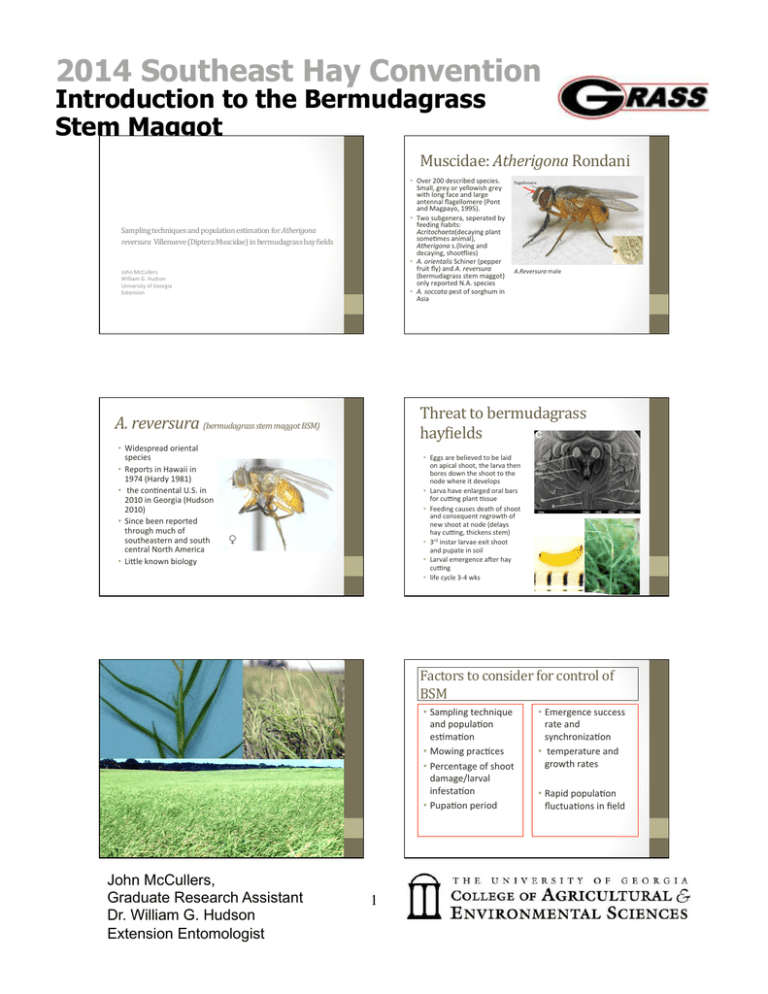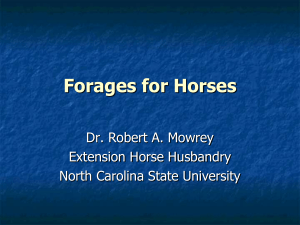Document 13139420
advertisement

2014 Southeast Hay Convention Introduction to the Bermudagrass Stem Maggot Muscidae: Atherigona Rondani • Over 200 described species. Small, grey or yellowish grey with long face and large antennal flagellomere (Pont and Magpayo, 1995). • Two subgenera, seperated by feeding habits: Acritochaeta(decaying plant someOmes animal), Atherigona s.(living and decaying, shooPlies) • A. orientalis Schiner (pepper fruit fly) and A. reversura (bermudagrass stem maggot) only reported N.A. species • A. soccata pest of sorghum in Asia Sampling techniques and population estimation for Atherigona reversura Villenueve (Diptera:Muscidae) in bermudagrass hay >ields John McCullers William G. Hudson University of Georgia Extension flagellomere A.Reversura male Threat to bermudagrass hay>ields A. reversura (bermudagrass stem maggot BSM) • Widespread oriental species • Reports in Hawaii in 1974 (Hardy 1981) • the conOnental U.S. in 2010 in Georgia (Hudson 2010) • Since been reported through much of southeastern and south central North America • LiXle known biology • Eggs are believed to be laid on apical shoot, the larva then bores down the shoot to the node where it develops • Larva have enlarged oral bars for cuZng plant Ossue • Feeding causes death of shoot and consequent regrowth of new shoot at node (delays hay cuZng, thickens stem) • 3rd instar larvae exit shoot and pupate in soil • Larval emergence a^er hay cuZng • life cycle 3-­‐4 wks Factors to consider for control of BSM • Sampling technique and populaOon esOmaOon • Mowing pracOces • Percentage of shoot damage/larval infestaOon • PupaOon period John McCullers, Graduate Research Assistant Dr. William G. Hudson Extension Entomologist 1 • Emergence success rate and synchronizaOon • temperature and growth rates • Rapid populaOon fluctuaOons in field 2014 Southeast Hay Convention Introduction to the Bermudagrass Stem Maggot Methods: poplation estimation Absolute(cage and vacuum) Methods • Both abs and rel samples taken in ~10m2 plots in random locaOons throughout field (3,6,10), various fields throughout the state ( 8 different locaOons, 15 dates July-­‐Oct) • Grass and fly samples taken to lab where flies counted, males/ females idenOfied, damaged shoots counted, grass height • The mean of the absolute samples was compared to relaOve samples in order to determine the relaOonship between the two. Regression analysis produced an equaOon to esOmate the overall fly populaOon. Rela4ve(sweepnet) • All flies vaccuumed from cage with .5 m2 footprint • 10 sweeps of net walking in straight line • 2-­‐3 absolute (abs)/relaOve (rel) • 1 grass sample/abs (18 in diameter) • All samples placed in bags with informaOon then chilled and taken to lab Methods: pupation period • Once grass samples sorted, larvae emerge from clippings • Larvae allowed to pupate then counted and placed in containers for adult emergence, pupaOon period recorded Results • Regression analysis of fly sample data yielded a highly significant regression with R²= 0.535 • If we mulOply the regression equaOon by 2 (the absolute sample was . 5 m²) we can esOmate the populaOon of flies in a given field: Abs = 2[1.21 + 0.143(Rel)], where Abs= # of flies/ m² and Rel= # of flies/ 10-­‐sweep sample John McCullers, Graduate Research Assistant Dr. William G. Hudson Extension Entomologist 2 2014 Southeast Hay Convention Introduction to the Bermudagrass Stem Maggot Results: pupation period Future studies • Preliminary results suggests that pupae from grass samples synchronously emerge as adults in 10 days at temperatures of 24-­‐27℃ with a high success rate. More data is needed under controlled condiOons. • AddiOonal trials to obtain a more accurate esOmate of the pupaOon period, success rate, and synchronizaOon of emergence will be carried out in incubators at varying temperatures (75-­‐95 ͦF). • Further sampling to establish correlaOon between fly populaOons and grass damage • ImplementaOon of prescribed treatments on individual fields based on populaOon esOmates, percentage of damaged grass, number of days since the last hay cuZng, and pupaOon period. • It may be that populaOons are beXer controlled iniOally at low levels when the flies are first detected a^er the spring emergence or a^er adult emergence following hay cuZngs. However, it is probable that fly populaOons disperse from local fields to nearby locaOons Acknowledgements/References Thanks to: Will Hudson, David BunOn, Dennis Hancock, Lindley Clark, Lisa Baxter, 4H • Hardy DE. 1981. Insects of Hawaii. Vol. 14, Diptera: Cyclorrhapha IV, series Schizophora secOon Calyptratae. Honolulu (HI): University of Hawaii Press. • Hudson W. 2010. New exoOc invasive fly found damaging Bermudagrass forage crops in Georgia [Internet]. Athens (GA): University of Georgia College of Agricultural and Environmental Sciences; [cited 2012 Apr 14]. Available from: hXp://www.caes.uga.edu/ApplicaOons/ImpactStatements/ind • Pont AC, Magpayo FR. 1995. Muscid shoot-­‐flies of the Philippine islands (Diptera: Muscidae, genus Atherigona Rondani). Bull Entomol Res. Suppl. 3:1–123. John McCullers, Graduate Research Assistant Dr. William G. Hudson Extension Entomologist 3



